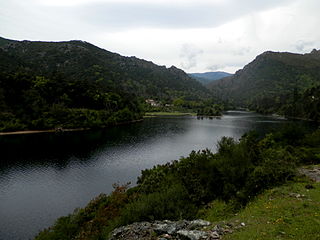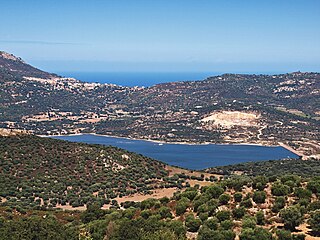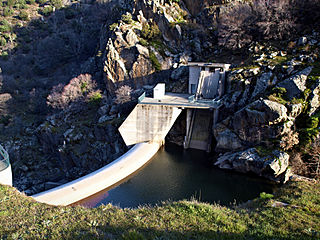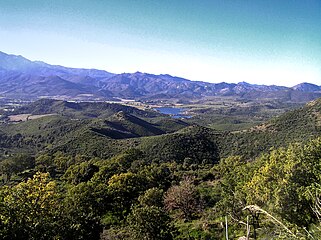Dam
After a fire in the Nebbio in 1989, the water tables in the Saint-Florent plain were empty. The reservoir was created to provide water for irrigation and firefighting. The dam was commissioned in 1991 and began to supply an irrigation network in the Oletta plain.
Requirements for drinking water in the nearby tourist center of Saint-Florent began to rise. An order of 9 November 2005 authorized use of water from the Aliso river and the Padula reservoir for human consumption. The Office d'Equipement Hydraulique de Corse (OEHC) was authorised to withdraw and treat up to 2,000,000 cubic metres (71,000,000 cu ft) of water during the peak summer tourist period in the Nebbio region. The land around the reservoir was protected.
Reservoir
Panorama of the lake
View from a distance
The lake lies among mountains and is surrounded by meadows, forest and wild plants. It covers 26 hectares (64 acres). The villages of Oletta and Olmeta-di-Tuda look over the lake from higher ground. Repopulation of the lake with fish is allowed, as is fishing. However, the lake may only be approached on foot, and swimming and all types of boating are prohibited.
The volume of water in the reservoir in the period from 2003 to 2009 fluctuated from a minimum of 800,000 cubic metres (28,000,000 cu ft) to a maximum of 1,900,000 cubic metres (67,000,000 cu ft). Average volumes were 1,100,000 to 1,800,000 cubic metres (39,000,000 to 64,000,000 cu ft).
The reservoir is upstream from the Aliso-Oletta Natura 2000 site. It has the effect of disrupting the natural flow of the Aliso river. Releases of water cause rapid influxes of water. In summer a small reserved flow of 0.007 cubic metres per second (0.25 cu ft/s) from the dam creates a minimum flow in the tributary and to some extent in the Aliso.

Barbaggio is a commune in the French department of Haute-Corse on the island of Corsica. It is known for its wine, its scenery, and the prehistoric site of Strette.
The canton of Biguglia-Nebbio is an administrative division of the Haute-Corse department, southeastern France. It was created at the French canton reorganisation which came into effect in March 2015. Its seat is in Biguglia.

Alesani Reservoir or Alesani Lake is a reservoir in the Haute-Corse department of France formed in 1970 by damming the Alesani River with the Alesani Dam. It is the main source of irrigation water along the east coast of Haute-Corse, and it also supplies water for human consumption and for hydroelectric power generation.

The Aliso River is a small coastal river in the department of Haute-Corse, Corsica, France.

The Bevinco is a small river in the northeast of the Haute-Corse department on the French island of Corsica. It is the main tributary of the Étang de Biguglia, the largest wetland in Corsica.

The Lac de l'Argentella is a reservoir in the Haute-Corse department of Corsica, France. It was built in the 1870s to supply water to the ore processing plant of the Argentella mines, which refined silver and copper ore extracted from the nearby Capu di l'Argentella. After a few years the ore supply became uneconomical, and eventually the mines were closed in the 1930s. Recently there has been discussion on what to do with the aging dam. It stores water in a dry region, but may be unsafe.

The Sampolo Reservoir is a reservoir in the Haute-Corse department of Corsica, France. It is formed by damming the Fiumorbo river by the Barrage du Sampolo. The reservoir provides hydroelectricity and water for irrigation. The gallery of the dam is home to important bat colonies.

The Col de Bigorno Corsican: Bocca di Bigornu), or Bigorno Pass, is a mountain pass in the Haute-Corse department of Corsica, France.

Lac de Calacuccia is a reservoir in the Haute-Corse department of France formed by damming the Golo river. It provides hydroelectric power and water for irrigation in the dry season.

Codole Reservoir is a reservoir in the Haute-Corse department of France, on the island of Corsica. It supplies water for drinking and irrigation. The reservoir and its immediate surroundings are important as a biotope that offers habitat for many species of birds, reptiles and amphibians

The Barrage de Corscia is a dam in the Haute-Corse department of France on the Golo river. It impounds an intermediate reservoir in the Golo hydroelectric complex. The Corscia hydroelectric power station fed by water channeled from Lac de Calacuccia has a capacity of 13 mW and discharges into the Corscia reservoir. Downstream from the Corscia reservoir there is another power station at Castirla.

The Alzitone Reservoir is a reservoir in the Haute-Corse department of France. It dams the Pedocchino stream, but most of the water is supplied from the Réservoir de Trévadine on the Fiumorbo river. It supplies water for drinking and for irrigation, which during the summer low water is delivered using a pumping station.

The Ortolo Reservoir is a reservoir in the Corse-du-Sud department of France on the island of Corsica.

The Ospedale Reservoir is a reservoir in the Corse-du-Sud department of France on the island of Corsica. It holds drinking water for the southeast of the island, including Porto-Vecchio. It is surrounded by a forest that has been designated a Zone naturelle d'intérêt écologique, faunistique et floristique (ZNIEFF).

The Figari Reservoir is a reservoir in the Corse-du-Sud department of France on the island of Corsica. It provides water for irrigation and human consumption.

The Lac de Tolla is a reservoir in the Corse-du-Sud department of France on the island of Corsica. It is the largest lake on Corsica, and powers a hydroelectric plant.

Trévadine Reservoir is a reservoir in the Haute-Corse department of France, on the island of Corsica. It stores water for drinking and irrigation, which is fed to reservoirs in the coastal plain.

Peri Reservoir is a reservoir in the Haute-Corse department of France, on the island of Corsica. It supplies water for drinking and irrigation to the central section of the eastern plain of Corsica. In peak periods it also supplies water to the southern section.

The Prunelli is a small coastal river in the department of Corse-du-Sud, Corsica, France. It flows into the Golfe d'Ajaccio on the Mediterranean Sea.

The Col de Santo Stefano Corsican: Bocca di San Stefanu) is a mountain pass in the Haute-Corse department of Corsica, France. It is one of the main passes in Corsica, running between the massifs of Monte Stello to the north and Monte Astu to the south. It provides a route from the Saint-Florent region to the northwest and Biguglia in the eastern coastal plain.
This page is based on this
Wikipedia article Text is available under the
CC BY-SA 4.0 license; additional terms may apply.
Images, videos and audio are available under their respective licenses.























